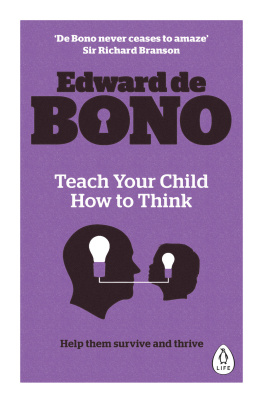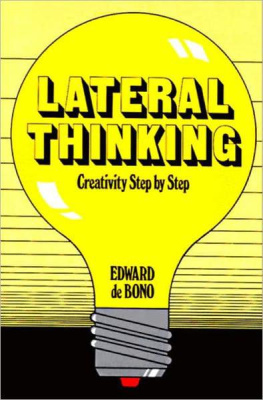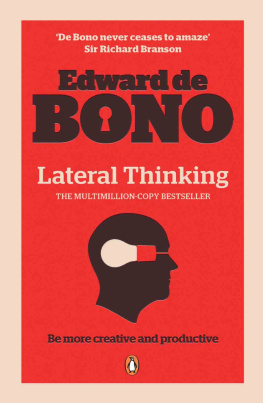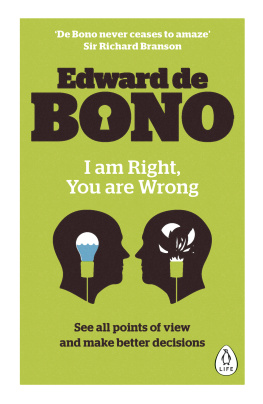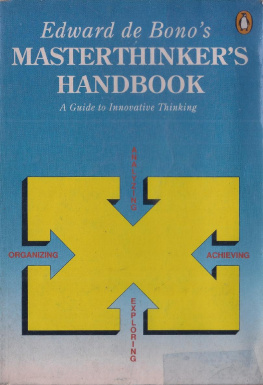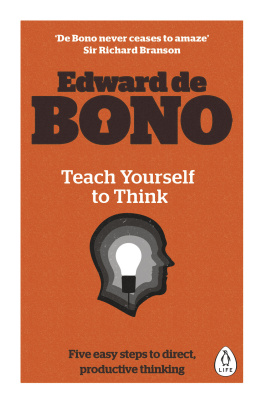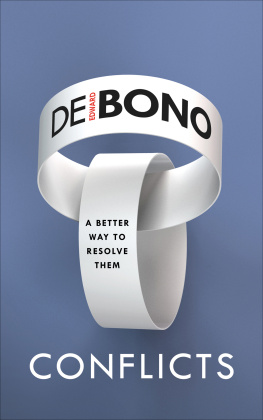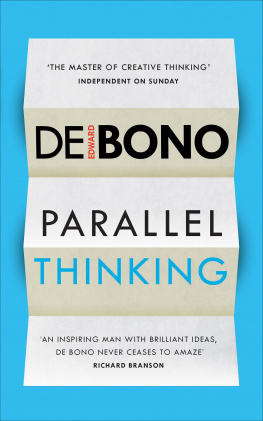Contents
Edward de Bono
TEACH YOUR CHILD HOW TO THINK
PENGUIN LIFE
UK | USA | Canada | Ireland | Australia
India | New Zealand | South Africa
Penguin Life is part of the Penguin Random House group of companies whose addresses can be found at global.penguinrandomhouse.com.
First published by Viking 1992
Published in Penguin Books 1993
Published in Penguin Life 2015
Copyright IP Development Corporation, 1992
The moral right of the author has been asserted
Cover Design: Dan Mogford
Edward de Bono hereby asserts his moral right to be known as the author of this work. For more information about training in Dr de Bonos method, see www.debono.com
ISBN: 978-0-241-33688-5
PENGUIN LIFE
TEACH YOUR CHILD HOW TO THINK
Edward de Bono invented the concept of lateral thinking. A world-renowned writer and philosopher, he is the leading authority in the field of creative thinking and the direct teaching of thinking as a skill. In the decades since Dr de Bono introduced lateral thinking, the concept has become so entrenched in our language that it is used equally in physics lectures, television comedies or brainstorming sessions. His key contribution has been his understanding of the brain as a self-organizing system. His work spans generations, continents and belief systems, and is equally influential in the boardrooms of leading businesses such as Apple and British Airways as on the shelves of classrooms in rural Africa.
Dr de Bono has written more than sixty books, in forty languages, with people now teaching his methods worldwide. He has chaired a special summit of Nobel Prize laureates, had faculty appointments at the universities of Oxford, London, Cambridge and Harvard, and been hailed as one of the 250 people who have contributed most to mankind.
Dr de Bonos classic bestsellers include Six Thinking Hats, Lateral Thinking, I Am Right You Are Wrong, How To Be More Interesting, Teach Yourself to Think, Teach Your Child How to Think and Simplicity.
www.debono.com
THE BEGINNING
Let the conversation begin
Follow the Penguin Twitter.com@penguinUKbooks
Keep up-to-date with all our stories YouTube.com/penguinbooks
Pin Penguin Books to your Pinterest
Like Penguin Books on Facebook.com/penguinbooks
Listen to Penguin at SoundCloud.com/penguin-books
Find out more about the author and
discover more stories like this at Penguin.co.uk
Part One
My one ambition in writing this book is that around the world there should be a few more young people who come to say:
I am a thinker.
I would be even more pleased if some of them were to go further and say:
I am a thinker and I enjoy thinking.
There is equal opportunity in this book for parents, and adults in general, to find themselves saying the same thing.
Thinking is not difficult. Thinking is not boring. You do not need to be a genius in order to be a good thinker.
The future well-being of the world is going to require good thinking. Personal life has always required good thinking but in the future the increasing complexity of demands and opportunities will require even better thinking. In business and professional life, good thinking is essential for survival, for success and for competition.
This Book is Not For You If
1. You believe that intelligence is enough. If you believe that a highly intelligent person is automatically a good thinker and that a person with a lesser intelligence is less of a thinker, this book is not for you.
In my experience highly intelligent people are not always good thinkers. Many highly intelligent people fall into the intelligence trap and function as poor thinkers.
Intelligence is a potential. Thinking is the skill with which we use that potential. I shall be discussing this point in more detail within a few pages.
2. You believe that thinking skills are already being taught in school. If you believe that school is the right place to teach thinking and that schools are doing this well, this book is not for you.
In my experience most schools do not teach thinking at all. Some schools teach the limited thinking skills involved in information sorting and analysis. Lately there has been something of a surge in the teaching of thinking in schools. Some schools have begun to teach critical thinking. This is worthwhile but is also insufficient and even dangerous on its own (as I shall explain later).
The CoRT Thinking Program which I designed is now in use with millions of students in various countries around the world. Even so, it is unlikely to be in use in the school your children attend.
3. You believe that thinking skills cannot be taught directly. If you believe that thinking skills can be developed only by thinking about specific subjects or applying thinking in everyday life, this book is not for you.
Most people in education, and many others elsewhere, have always believed that thinking cannot be taught directly. This view is now beginning to change as experience and research begins to show that thinking skills can be taught directly.
Because we spend a lot of time thinking about things does not by itself improve our thinking skills. A journalist who types with two fingers will still be typing with two fingers at the age of sixty. This is not for lack of typing practice. Practice in two-finger typing will serve only to make that person a better two-finger typist. Yet a short course in touch typing at a young age would have made that person a much better typist for all his or her life. It is the same with thinking. Practice is not enough.
Introduction: Why We Need New Thinking About Thinking
INFORMATION AND THINKING
Information is very important. Information is easy to teach. Information is easy to test. It is not surprising that so much of education is concerned with information.
Thinking is no substitute for information but information may be a substitute for thinking.
Most theological definitions grant God perfect and complete knowledge. When knowledge is perfect and complete there is no need for thinking.
In some areas we might be able to achieve complete information and then those areas become routine matters that require no thinking. In the future we shall hand over these routine matters to computers.
Unless we have complete information we need thinking in order to make the best use of the information we have. When our computers and information technology give us more and more information we also need thinking in order to avoid being overwhelmed and confused by all the information.

